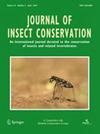阳光充足、炎热潮湿、植被多样的筑巢地点有利于地中海地区杏仁果园附近的奥斯米亚蜜蜂
IF 1.9
3区 农林科学
Q2 ENTOMOLOGY
引用次数: 0
摘要
摘要野生蜜蜂(膜翅目:野蜂总科)在许多作物和大蜂科(Osmia spp.)管理种群中发挥着重要的传粉作用,通过设置陷阱巢在一些果园中被证明是有效的。为了优化陷阱-巢方案,有必要了解哪些环境因素在这些蜜蜂的繁殖成功中起主要作用。本文研究了气候、土地利用和植被如何影响西班牙东南部地中海地区杏树园附近的奥斯米蜂的占巢率(OR,即蚁巢总数/陷阱巢中隧道总数)、育蜂生产力(BP,即在一个完整的巢隧道中建造的育蜂细胞总数)和寄生率(PR,即被寄生的育蜂细胞总数/BP)。结果表明,夏季太阳辐射对OR和BP均有显著正影响,而春季太阳辐射对OR和BP均有显著正影响,而对PR均有显著负影响。牧草和森林丰度高于作物增加了OR,但对BP没有显著影响,而对PR有显著降低。在最暖月份,BP随最高气温升高而升高,随年温差升高而降低。PR也随着高温和降水的增加而增加。干旱条件限制了OR和BP,促进了寄生。总的来说,在这个地区杏仁田附近的奥斯米亚蜜蜂似乎会受益于在太阳辐射良好、湿热、植被多样的地方安装陷阱巢。由于我们还发现至少有一个寄生细胞的巢中PR和BP之间存在负相关,因此提高生产力的环境条件也可能减少这些蜜蜂的寄生。昆虫保护的意义优化陷阱筑巢方案,以保持丰富的奥斯米亚种群是至关重要的有效利用这些蜜蜂作为管理传粉媒介。在我们的研究中,我们建议选择陷阱巢的位置也应该考虑到一些当地的气候和栖息地因素,因为它们对这些独居蜜蜂繁殖成功的关键特征有重要影响。本文章由计算机程序翻译,如有差异,请以英文原文为准。
Sunny, hot and humid nesting locations with diverse vegetation benefit Osmia bees nearby almond orchards in a mediterranean area
Abstract Wild bees (Hymenoptera: Apoidea) play an important role as pollinators of many crops and managed populations of Osmia spp. (Megachilidae), through the installation of trap-nests, proved to be efficient in several fruit orchards. In order to optimize the trap-nest protocols, it is necessary to understand which environmental factors play a major role in the reproductive success of these bees. Here, we studied how climate, land use and vegetation affect nest occupation rate (OR, i.e. total number of colonized tunnels/total number of tunnels in the trap-nest), brood productivity (BP, i.e. total number of brood cells built in a completed nest tunnel) and parasitism rate (PR, i.e. total number of parasitized brood cells/BP) in Osmia bees nearby almond orchards in South-East Spain, a largely understudied Mediterranean area. We found that the summer solar radiation positively influenced all three parameters, while spring solar radiation positively affected OR and BP, and negatively PR. Higher abundance of pastures and forests compared with crops increased OR, though not BP, and reduced PR. Vegetation evenness and diversity of dominant plant species also positively affected OR and BP, while they were unimportant for PR. OR was not affected by climate, but BP increased with maximum temperature in the warmest month and decreased with temperature annual range. PR also increased with high temperature, as well as with precipitation. Arid conditions limited OR and BP and boosted parasitism. Overall, it seems that Osmia bees nearby almond field in this area would benefit from trap-nest installation in well solar-radiated, hot and humid sites with a diverse vegetation. Since we have also found a negative association between PR and BP in nests with at least one parasitized cell, environmental conditions which improve productivity will also likely reduce parasitism in these bees. Implications for insect conservation Optimization of trap-nesting protocols for maintaining abundant Osmia populations is crucial to an effective use of these bees as managed pollinators. In our study we suggest that trap-nests locations should be chosen also taking into account a number of local climatic and habitat factors, given their importance in affecting key traits of reproductive success in these solitary bees.
求助全文
通过发布文献求助,成功后即可免费获取论文全文。
去求助
来源期刊
CiteScore
3.60
自引率
10.50%
发文量
76
审稿时长
6 months
期刊介绍:
The Journal of Insect Conservation is an international journal devoted to the publication of articles concerned with the conservation of insects and related invertebrates. The Journal of Insect Conservation publishes papers on all aspects of conservation and biodiversity related to the insects and closely related groups such as Arachnids and Myriapods, including ecological work which has conservation implications. Research papers may address the subject at the community, population or species level, may cover aspects of behaviour, taxonomy or genetics, be theoretical or practical, and be local or global in nature. Review articles are welcome as well as points of view which are likely to stimulate debate. From time to time the journal will publish Special Issues on specific subject areas which are the focus of current research. Proposals for such issues are welcome.

 求助内容:
求助内容: 应助结果提醒方式:
应助结果提醒方式:


